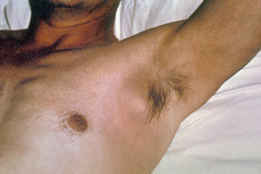How infectious diseases are spread and simple and practical advice for preventing the spread of infection in the home and community
Plague - including symptoms, treatment and prevention
In the 6th, 14th to 17thand 19th centuries plague swept across Europe, Asia and Africa in devastating pandemics. The pandemic of the 14th to 17th century was known as the Black Death, with an estimated 75 to 200 million people dying.
The last cases of human plague in Australia occurred in the 1920s. However, plague may occur in overseas travellers as it still occurs in many countries in Africa, the former Soviet Union, the Americas and Asia.
The plague is a notifiable condition1
There are three main types of plague, these are:
- bubonic
- septicaemic
- pneumonic.
Someone with one form of plague may then develop another form.
How plague is spread
Plague is caused by the bacterium Yersinia pestis.
Plague bacteria are found in small animals (for example, rats or guinea pigs) and their fleas in parts of Africa, the Americas and Asia but not in Australia.
The bacteria are spread between animals and humans by the bite of infected fleas, direct contact with infected animals, or breathing in the bacteria from infected animals.
Direct person to person spread can occur through:
- breathing in small droplets in the air containing the plague bacteria which are coughed or breathed out by someone with pneumonic (lung) plague or pharyngeal (throat) plague
- direct contact with pus from buboes, although this is rare.
Y. pestis is a potential bioterrorism agent.
Signs and symptoms of plague
Early symptoms of any form of plague may include:
- fever
- chills
- malaise (general feeling of unwellness)
- muscle aches
- nausea
- sore throat
- headache.
 People with bubonic plague develop painful inflamed lymph nodes (see image) which may release pus. These are called buboes.
People with bubonic plague develop painful inflamed lymph nodes (see image) which may release pus. These are called buboes.
Septicaemic plague is infection in the blood. Symptoms may include:
- abdominal pain
- vomiting
- blackening of fingers, toes or nose
- bleeding.
Pneumonic plague is infection in the lungs. Symptoms may include a cough.
Image courtesy Public Health Image Library (PHIL), Department of Health and Human Services, Centers for Disease Control and Prevention (CDC-USA)
Diagnosis of plague
Plague is diagnosed by laboratory testing on bubo fluid, sputum or cerebrospinal fluid (CSF)2
Incubation period
(time between becoming infected and developing symptoms)
1 to 7 days. It may be shorter (1 to 4 days) in persons who first develop pneumonic plague.
Infectious period
(time during which an infected person can infect others)
Bubonic plague does not usually spread directly from person to person unless there is direct contact with pus from buboes.
Pneumonic plague (and pharyngeal plague) is very infectious.
People with plague are usually no longer infectious after receiving 48 hours of appropriate antibiotic treatment.
Treatment for plague
Plague is a medical emergency. People with suspected or confirmed plague should be managed in a hospital. People with plague are usually cured if treated with appropriate antibiotics early.
Without treatment pneumonic and septicaemic plague are almost always fatal and 50 to 60% of people with bubonic plague die from the disease.
Contacts3 of people with plague may need antibiotics.
Prevention of plague
Australia’s quarantine restrictions prevent plague occurring in Australia by stopping importation of sick small animals.
People in areas where plague occurs should wear gloves when handling wild animals.
Useful links
1 - In South Australia the law requires doctors and laboratories to report some infections or diseases to SA Health. These infections or diseases are commonly referred to as 'notifiable conditions'.
2 - Cerebrospinal fluid: the fluid surrounding the brain and spinal cord
3 - A contact is any person who has been close enough to an infected person to be at risk of having acquired the infection from that person
Image - Image courtesy of Public Health Image Library (PHIL), Department of Health and Human Services, Centers for Disease Control and Prevention (CDC-USA)